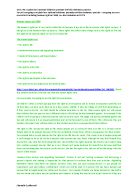Harassment: harassment is when someone behaves in a way which makes you feel distressed, humiliated or threatened. It could be someone you know, like a neighbor or people from your local area or it could be a stranger - for example, someone on the bus. Examples of harassment include: unwanted phone calls, letters, emails or visits. Bullying itself isn’t against the law, but harassment is. This is when the unwanted behavior is related to one of the following: Age, sex, disability, gender, marriage and civil partnership, pregnancy and maternity, race, religion and belief, sexual orientation.
Harassment policies should state what harassment is, that it is illegal and prohibited in the care setting that the policy is for. It should also say that there will be consequences for anyone found harassing another person.
Confidentiality: Any information a service user provides is private and confidential, whether it be verbal, written, photographic or electronic (for example, an email). Information should only be recorded when necessary and must be destroyed when it is no longer needed. The information recorded should be purely facts, no opinions. The Data Protection Act 1998 gives very clear guidelines about what can and cannot be recorded, how it should be recorded and that all information must be legible, accurate and up-to-date. Care workers also must be clear of who will view the records, what they will be used for, and what the aim of the records are.
Confidentiality policies should state what is expected of all care workers and service users in the care setting, and clearly state the laws regarding breach of confidentiality, and what will happen if confidentiality regulations are breached.
Health and safety: health and safety regulations and procedures intended to prevent accident or injury in workplaces or public environments.
A health and safety policy should describe how the care setting will manage health and safety and will let the staff and others know about the care settings commitment to health and safety. It should clearly say who does what, when and how, and what the consequences will be if the policy is not followed.
Procedures
Positive promotion of individual rights: positive promotion of individual rights could be promoted for example by notice boards in the hallways, reception areas or staff rooms. Having a charter and having the charter on display for the service users to read would promote individual rights as it would show the service users what to expect from the service so that if they are not receiving top quality care then they can act upon this.
In addition, policies and procedures should be available for the service providers to read to help them guide to certain things if they are unsure about anything or they can be informed of where the policies and procedures can be found. Staff should be given handbooks or printed out copies of the regulations, legislations, charters etc. when they are first employed, and regular training should be given to make sure that all health and social care workers are kept up to date with changes and reminded of their duty of care.
Advocacy: advocacy is when a person is speaking or representing another individual who are too ill or frail to speak for themselves or they don’t even know their own rights as an individual and requires assistance for someone to make these decisions related to care or treatment. The advocate can be a professional worker or even a friend or relative and next of kin. But the advocate should make sure they are talking on behalf of the individual and not put their own views across.
Staff recruitment: The ability of each candidate to perform a job should be compared objectively against the selection criteria for that job, and all applications for a post should be processed in the same way, regardless of race, gender, sexuality etc. Information sought from candidates and passed to those responsible for appointments should relate only to the qualifications for or requirements of the job. Every work place has a statutory obligation to make such adjustments to the workplace and to working arrangements as are reasonable to accommodate suitably qualified disabled applicants
Development and training: development and training is another way to promote an anti discriminatory practice as health and social care service providers would be fully trained and they would have to keep up to date with changes in policies and procedures as well as legislations and technology. All these changes are updated and very important for service providers to follow as technology changes rapidly and so do procedures. Equality, diversity and rights legislation are also updated and staff must be informed of these changes when they arise.
Complaints procedures: When a complaint is made in a care setting, all complaints should be taken seriously, whether they are made verbally, written, or by email. The person making the complaint should be treated fairly and with courtesy, and confidentiality should be maintained at all times unless the person making the complaint gives permission to act otherwise.
Anti-discriminatory practice
Anti-discriminatory practice aims to counteract the negative effects of discrimination on service users and/or care workers. All employees in a health and social care setting should promote this practice to ensure equality for everyone in the setting and help get rid of any discrimination.
This is important because it ensures that the effects of discrimination don’t prevent service users’ needs being met, For example in a school if a child goes to the afterschool homework help club, but one of the teachers there repeatedly ignores him because he is black, he may stop going to the homework help club and end up getting in trouble in class for not doing his homework, however if the school had anti-discriminatory practices and he wasn’t discriminated In the first place then he would be receiving the help he needs to succeed in his work, which in turn helps his overall education.








